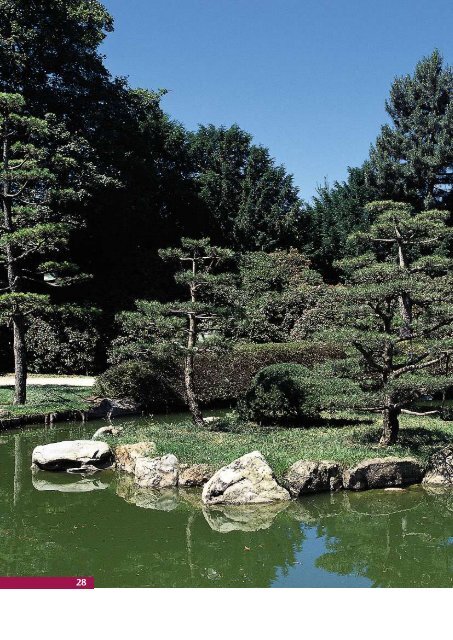Click here to read the whole article (881 KB) - European-Hospital
Click here to read the whole article (881 KB) - European-Hospital
Click here to read the whole article (881 KB) - European-Hospital
You also want an ePaper? Increase the reach of your titles
YUMPU automatically turns print PDFs into web optimized ePapers that Google loves.
The Japanese<br />
Garden<br />
yn<strong>the</strong>sis of <strong>the</strong><br />
Senses<br />
For many <strong>European</strong>s <strong>the</strong> ideal garden is <strong>the</strong><br />
romantic dream of that safe haven w<strong>here</strong> man<br />
and nature, both unspoilt and benign, live in<br />
harmony, far away from <strong>the</strong> ugly and mundane<br />
of everyday life. T<strong>here</strong> are red rose bushes and<br />
mallow; white rhododendrons and hydrangeas<br />
nestle in <strong>the</strong> semi-shade underneath <strong>the</strong> apple<br />
tree; in <strong>the</strong> grass next <strong>to</strong> <strong>the</strong> small pond with <strong>the</strong><br />
reeds large daisies have been allowed <strong>to</strong> sp<strong>read</strong><br />
merrily, and over t<strong>here</strong>, only a few steps away<br />
from <strong>the</strong> terrace, parsley and rosemary are <strong>read</strong>y<br />
and waiting <strong>to</strong> be picked for dinner. The birds are<br />
singing in <strong>the</strong> trees and <strong>the</strong> air is filled with gentle<br />
humming and buzzing of tiny animals which<br />
seem <strong>to</strong> have been making this peaceful place<br />
<strong>the</strong>ir home for centuries. You want <strong>to</strong> lie in <strong>the</strong><br />
grass and dream in <strong>the</strong> sunshine...<br />
T he Japanese gardener takes quite a<br />
different view – his planting is not dictacted<br />
by <strong>the</strong> eye but by <strong>the</strong> soul. His garden is<br />
charged with no less a task than <strong>to</strong> express<br />
century-old Eastern mythology: it is a mental<br />
attitude and religious belief. His garden is<br />
w<strong>here</strong> Buddha lives.<br />
The German landscape architect Christhard<br />
Ehring explains: “The Far East knows no hierarchy<br />
of creation. Man regards himself as part of<br />
living and inanimate nature; mountains, rocks,<br />
lakes, rivers, man and animal are ‘nearly equal’,<br />
<strong>the</strong>y are all creatures of <strong>the</strong> cosmos. That is<br />
why <strong>the</strong> stylistic elements of a Japanese garden<br />
are not objects of decoration but traditional<br />
components of nature.“<br />
29
Accordingly, s<strong>to</strong>nes represent mountains and<br />
rocks, raked gravel or sand, <strong>the</strong> sea and<br />
trimmed bushes, wooded hills – at <strong>the</strong> same<br />
time symbolising Paradise w<strong>here</strong> Buddha lives.<br />
Consequently, <strong>the</strong> <strong>European</strong> and <strong>the</strong> Japanese<br />
gardener are worlds apart. In Germany, for example,<br />
it takes three years <strong>to</strong> become a gardener,<br />
in Japan, ten. The required standard of<br />
knowledge of traditional culture, which in<br />
Japan dates back <strong>to</strong> <strong>the</strong> 8th century, is incomparably<br />
higher.<br />
Such knowledge encompasses <strong>the</strong> <strong>the</strong>ory of<br />
feng-shui which has recently found its way<br />
in<strong>to</strong> <strong>European</strong> living rooms. The <strong>the</strong>ory of <strong>the</strong><br />
earth’s natural energy streams (geomancy)<br />
is included in all aspects of house and garden<br />
design. No Japanese person would dream of<br />
building a house without first discussing<br />
position, orientation and <strong>the</strong> layout of doors<br />
and windows with a geomancer. The Tao<br />
concept of yin and yang is ano<strong>the</strong>r significant<br />
aspect of Japanese garden design.<br />
Y in represents <strong>the</strong> soft, feminine principle,<br />
yang, <strong>the</strong> hard, masculine principle. Applied<br />
<strong>to</strong> a Japanese garden this means that a (hard)<br />
rock requires (soft) water in a certain proportion<br />
as not <strong>to</strong> disturb <strong>the</strong> harmony of nature<br />
(and <strong>the</strong> cosmos). Or a radically trimmed dry<br />
plant needs <strong>to</strong> be balanced by just <strong>the</strong> right<br />
amount of naturally grown moist moss.<br />
In view of such challenges a Japanese gardener<br />
cannot wait until a tree or a bush has reached<br />
its full size years later – when it may well end<br />
up upsetting <strong>the</strong> balance of <strong>the</strong> overall composition.<br />
His garden is complete and finished as<br />
soon as it has been built while his <strong>European</strong><br />
colleague may return a year later <strong>to</strong> see how<br />
30<br />
his plants have developed. And a Japanese<br />
garden designer would never consider a garden<br />
independently of a house or a flat. For<br />
him, <strong>the</strong> garden is as much part of <strong>the</strong> house<br />
as <strong>the</strong> living room; in fact, <strong>the</strong> garden is part of<br />
<strong>the</strong> living room. Even w<strong>here</strong> space is tight, a<br />
Japanese person will always try <strong>to</strong> fit a “Tsuboniwa”,<br />
a miniature garden, in<strong>to</strong> <strong>the</strong> inner<br />
courtyard w<strong>here</strong> <strong>the</strong> gardener will try his best<br />
<strong>to</strong> create an impression of space even if <strong>the</strong><br />
<strong>whole</strong> garden is <strong>to</strong>y-size. And w<strong>here</strong> t<strong>here</strong> is<br />
space for a small water stream, <strong>the</strong> origin of<br />
<strong>the</strong> Tsubo-niwa in <strong>the</strong> large pond garden becomes<br />
apparent.<br />
The pond garden is <strong>the</strong> oldest of Japan’s<br />
traditional gardens. Its origins go back <strong>to</strong> <strong>the</strong><br />
large-scale water landscapes designed for a<br />
palace or a temple between <strong>the</strong> 8th and <strong>the</strong><br />
12th century. On a large pond bridges linked<br />
small islands. The most important feature<br />
was its position within <strong>the</strong> landscape.
T he “Sakutei-ki“, <strong>the</strong> oldest surviving<br />
manual of garden design dating from <strong>the</strong><br />
11th century, contains <strong>the</strong> following passage<br />
highlighting <strong>the</strong> Buddhist core of garden<br />
philosophy: “Design <strong>the</strong> pond with respect <strong>to</strong><br />
its position in <strong>the</strong> land, follow its request …<br />
think of <strong>the</strong> mountains and waters of living<br />
nature and reflect constantly upon such<br />
settings.”<br />
The development of dry gardens between<br />
<strong>the</strong> 12th and <strong>the</strong> 15th century was strongly<br />
influenced by Zen Buddhism. Zen, <strong>the</strong> form of<br />
Buddhism which strives for an ideal state of<br />
perfect emptiness, used <strong>to</strong> be <strong>the</strong> religion of<br />
<strong>the</strong> Samurai, <strong>the</strong> sword fighters. Water is symbolised<br />
by gravel or sand; <strong>the</strong> garden’s abstract<br />
and very graphic composition, a ”visual manifestation<br />
of emptiness“, serves as an aid <strong>to</strong><br />
meditation.<br />
The tea garden, which originated in <strong>the</strong> 16th<br />
century, is <strong>the</strong> setting for one of <strong>the</strong> most elegant<br />
ceremonies in <strong>the</strong> world, <strong>the</strong> Japanese tea<br />
ceremony. Meant <strong>to</strong> convey <strong>the</strong> image of a remote<br />
mountain village, it is planted with ferns<br />
and grasses which are contrived <strong>to</strong> appear natural.<br />
Only when immersed in <strong>the</strong> ceremony<br />
does <strong>the</strong> observer realise <strong>the</strong> planned beauty<br />
through which <strong>the</strong> visi<strong>to</strong>r is guided by carefully<br />
placed stepping s<strong>to</strong>nes.<br />
In Germany, one of <strong>the</strong> most successful examples<br />
of a Japanese garden can be seen in<br />
Düsseldorf. In 1975, <strong>the</strong> landscape architect<br />
Iwaki Ishiguro and his son Shojiro created <strong>the</strong><br />
“Japanischer Garten am Rhein“ in <strong>the</strong> Düssel-<br />
“D ESIGN THE POND WITH<br />
RESPECT TO ITS<br />
POSITION IN THE LAND,<br />
FOLLOW ITS REQUEST …<br />
THINK OF THE MOUNTAINS<br />
AND WATERS OF LIVING<br />
NATURE AND REFLECT<br />
CONSTANTLY UPON SUCH<br />
SETTINGS.”<br />
31
32<br />
dorf Nordpark covering 5,000 square meters.<br />
A gift from <strong>the</strong> city’s Japanese community, it<br />
was built using only local or Japanese plants<br />
known <strong>to</strong> thrive in Europe. It is <strong>here</strong> that <strong>the</strong><br />
philosophy and his<strong>to</strong>ry of <strong>the</strong> au<strong>the</strong>ntic Japanese<br />
gardening tradition may be found w<strong>here</strong><br />
nature itself provides not merely <strong>the</strong> stage but<br />
is instead an active participant and performer.<br />
Or <strong>to</strong> quote from Zen philosophy: ”Something<br />
long represents <strong>the</strong> long body of Buddha.<br />
Something short represents <strong>the</strong> short body of<br />
Buddha.”
















